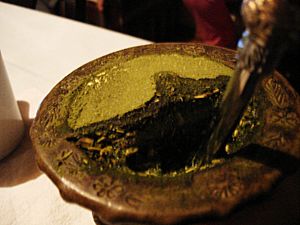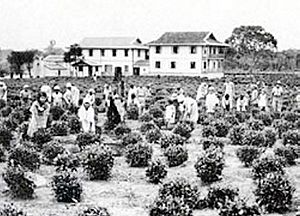Brazilian tea culture facts for kids
Brazilian tea culture is all about the many different kinds of chás (pronounced shahz), which are hot or cold drinks made by soaking plants in water. This tradition started with the native people of the Amazon and Rio da Prata areas. Over time, especially after the Portuguese arrived, new types of teas and ways of drinking them became popular. Many people in Brazil, especially in cities, like to add sugar to their teas. They are not used to drinking them plain.
Contents
What is Mate Tea?
One very popular drink in Brazil is mate. It has caffeine, just like coffee, and is made from the leaves of a plant called erva-mate. In Brazil, this plant is often just called mate.
How Brazilians Drink Mate
In the southern part of Brazil, especially in Rio Grande do Sul, people drink a hot version of mate called chimarrão. They drink it from a special cup made from a calabash gourd using a metal straw. This way of drinking mate comes from the native cultures who first shared it.
Mate is also very popular in other South American countries like Argentina, Paraguay, and Uruguay. In some areas, especially near the border with Paraguay, people drink mate with cold water. This cold version is called tereré.
Popular Teas in Brazil
Besides mate, other types of tea are common in Brazil. These include black tea (called chá-preto), which people drink hot or iced. Brazilians also enjoy many local kinds of herbal teas.
Lemongrass Tea
Lemongrass tea is a favorite. Lemongrass is a plant from Southeast Asia that grows very well in Brazil's warm climate. Brazilians call it capim-santo, capim-limão, or capim cidreira. People mostly drink it as a herbal tea or in health drinks. Many infusions in Brazil, including lemongrass drinks, are thought to have health benefits. For example, a cold drink made with lemongrass and pineapple peels is called chá de abacaxi com capim-santo.
Other Common Herbal Teas
Many other plants are used to make everyday teas in Brazil. These include:
- Melissa officinalis, known as erva-cidreira or citronela.
- Mint, called hortelã. While mint juices are very popular, tea is usually made from dried mint.
- Fennel (Foeniculum vulgare), known as erva-doce or funcho.
- Anise (Pimpinella anisum), also called erva-doce.
- Chinese star anise, known as anis-estrelado.
- South American lemon verbena, called lúcia-lima.
Many other plants are also used for teas, some for their taste and others for traditional health reasons.
Indigenous Teas
Brazil's native people have used many local herbs for teas. These teas often have traditional healing uses. Some are even part of special religious ceremonies.
Mint Tea for Health
One example is mint tea made from the plant Hyptis crenata. Traditional healers have used this tea to help with headaches, fevers, and the flu.
History of Tea in Brazil
Tea plants were first grown in Brazil in 1812, during the time when Portugal ruled Brazil. For many years in the 1800s, tea farms, much like coffee farms, relied on enslaved people to do the work. When slavery ended in Brazil in 1888, the tea business struggled.
In the 1920s, Japanese immigrants helped bring the tea industry back to life. They brought new tea seeds from Sri Lanka and India. Before this, only Chinese types of tea had been grown in Brazil.
Where Brazilian Tea Grows
The biggest tea-growing area in Brazil is near Registro, a city close to São Paulo. This area has low, rolling hills that are good for growing tea with machines. The tea-growing season in Brazil is from September to April, when the weather is hot and humid.
However, most tea farms in Brazil are not very high up. Teas grown at lower altitudes usually have less flavor than teas from high mountains. Because of this, Brazilian teas are often used for mixing with other teas. About 70% of all tea grown in Brazil is sold to the United States, where it is used in both iced and hot tea blends.



